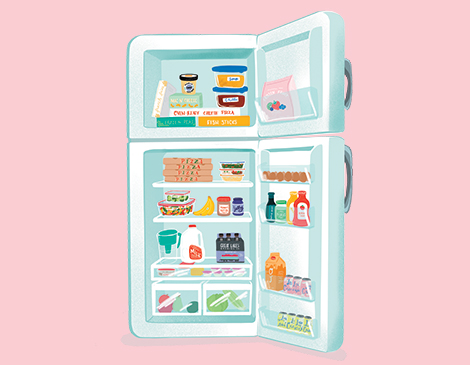If you’re like us, the fridge can be a bit of a mess. It’s just so easy to close the door and forget about last week’s leftovers, expired bottles of ketchup, and shriveled veggies past their prime. Christina Hidek, who runs the local organizing service, Streamlined Living, says keeping your fridge neat and tidy is important for ensuring you get the most bang for your buck. “When you can see and access what you’ve purchased, you’re getting to it before it spoils,” she says. Hidek recommends organizing your fridge weekly and gives us some pointers for how to make the most of each storage zone.
Freezer
To make the most of your space, Hidek recommends creating separate zones in the freezer for meat, fruit, precooked meals, and microwaveable foods such as breakfast sandwiches or burritos. Labeling any leftovers or precooked meals helps here too. “That way you’re not freezing your hands looking for what you need,” she says. Besides, making things easy to find keeps cold air from escaping into your home.
Main Shelves
Hidek likes to organize the main shelves by sections as well, keeping related items, such as leftovers, meat or ingredients for an upcoming meal in one spot, and things like peanut butter, jelly and dairy products in another. “If you put them all together rather than fitting them in Jenga-style you’ll be able to see and use them,” she says. She recommends using square, clear glass storage containers with lids, like Pyrex, for leftovers and cut veggies because of their ability to fit side by side or on top of each other easily.
Crisper
Believe it or not, there’s a science to fruit storage. Apples and pears emit a type of gas that helps ripen other produce, so Hidek advises keeping them near sealed items — think bagged baby carrots, broccoli florets or things that need to be ripened such as a rock hard avocado. Also, consider the humidity needs of the produce, as some fridges allow for different humidity controls. “Produce that wilts, like lettuce, celery and berries, should be kept in a high-humidity drawer, whereas produce that rots such as apples, stone fruit and cantaloupe are best in a low-humidity drawer,” she says.
Doors
Organizing the doors depends on the individual’s needs, but there are two universal guidelines. This part of the fridge gets the most temperature fluctuation, so dairy should not be stored here, instead opt for lining up your condiments or beverages for easy access. Regardless of what you keep here, Hidek says to use this trick: “Things you don’t use very often should be at the top or bottom and things that you use frequently should be in the middle so you can grab what you use most often quickly.”
Drawers
If your fridge has other drawers besides the crisper, Hidek says to keep multiples of things like yogurt, sliced cheese or deli meats organized front to back with the oldest in front and newest in the back. Plus, you don’t want your extra carton of hummus or guacamole to get lost in the back, so be conscious of where you’re putting smaller items. “You have to order things by size and do bigger, chunkier stuff at the back and then smaller things in the front,” she says.




